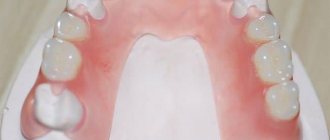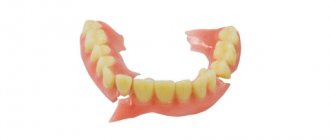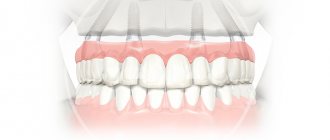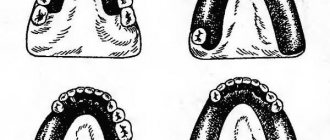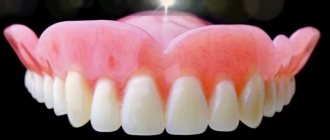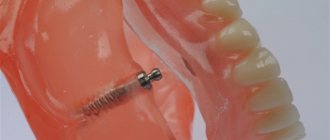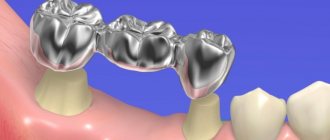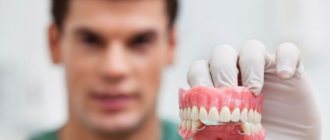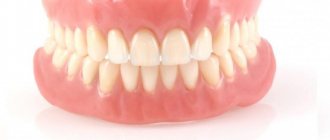Chief editor of the site:
Snitkovsky Arkady Alexandrovich
Chief physician of the professorial dentistry “22 Century”, dentist, orthopedic dentist
Author of the article:
Scientific team of dentistry “22 Century”
Dentists, candidates and doctors of medical sciences, professors
Dental prosthetics is a sequential multi-stage process. It is the high-quality implementation of each of them that leads to an excellent final result. There are main stages of prosthetics , some of them have their intermediate stages. They can also be clinical, that is, performed in a doctor’s office, and laboratory, in a dental laboratory. The main ones include: examination, preliminary treatment, prosthetics. The last stage includes the restoration of supporting teeth , their preparation, taking impressions, determining the closure of the jaws, fixing temporary structures, fitting and fixing permanent dentures and an adaptation period. Laboratory stages are carried out by a dental technician after taking impressions and determining occlusion (closing of the jaws). Before starting any treatment, it is necessary to draw up a treatment plan.
Oral examination
Any treatment process must begin with an examination. A preliminary examination allows you to determine the need for prosthetics, choose the optimal type of design and amount of work.
Examination of the oral cavity in dentistry Additional examination (instrumental, x-ray, etc.) provides information about the condition of the supporting teeth, periodontal tissue, bone tissue, the need for root canal treatment, and the possible presence of inflammatory elements at the tops of the root canals or in the bone.
This is an integral stage of successful prosthetics, as it allows not only to identify and eliminate hidden problems, but also to avoid possible complications in the future, after installation of the prosthesis .
Preliminary treatment
Dental treatment is an important point not only before prosthetics or implantation, but throughout life. Timely sanitation of the oral cavity preserves the health and integrity of the dental system, avoids possible complications, as well as the spread of infection throughout the body. Treatment of abutment teeth , hidden and obvious carious cavities, acute inflammatory processes in periodontal tissues or bones is mandatory before starting any prosthetics. This will allow not only to eliminate defects or diseases that have arisen in a timely manner, but also to extend the service life of the prosthesis. Also, some fixed structures require mandatory endodontic treatment.
Materials for the manufacture of prostheses
For permanent restorations, metals, ceramics and zirconium dioxide are used. Metal-ceramic crowns consist of 2 layers: a metal base, which is lined with a ceramic composition. Thick double walls require strong turning. Zirconium crowns are very durable, so the teeth need to be prepared minimally for them. New ceramic compositions, such as E-max, are quite durable and at the same time make it possible to choose the color of teeth of any shade.
The same materials can be used for conditionally removable prosthetics.
For removable dentures, the most important element is the base. The base is made from:
- Acrylic
- Acry Free
- Nylon
The hardest material is acrylic. Its disadvantages are microporosity and rapid wear. Acrylic contains substances that cause allergies. Pros: low cost and ease of processing.
Acry Free is a material that contains no allergens, it is softer and thinner than acrylic. It is easier to get used to such a product.
Nylon restorations fit comfortably in the mouth and do not cause allergies, but do not distribute the chewing load well enough due to their softness.
Metals and plastics are used for fastening elements of partial removable structures. And for the base - the same acrylic and plastics based on acrylic resins.
The service life of acrylic restorations is about 3 years, Acry Free and nylon restorations are 5 years. Dentures are replaced for several reasons. This could be a breakdown, an allergy, or a desire to replace an old design with a more modern one. The main thing is that removable structures do not stop bone loss. The relief of the oral cavity changes, the gums sag, and the restoration no longer fits.
Stages of dental prosthetics
Rarely does dental prosthetics happen in a single stage; generally, it is a sequential, multi-stage process. After preliminary endodontic treatment, it is necessary to restore the supporting teeth using inlays or pins. Then the doctor prepares (grinds) them to create a place for the prosthetic structure, takes impressions from both jaws and the prosthetic area, and determines the color of the artificial teeth. A very important step in prosthetics is determining the occlusion (the relationship of the jaws), which allows you not to interfere with the prosthesis during chewing. The impressions are sent to the dental laboratory. This is a kind of information for a dental technician about the shape and size of the teeth, the anatomical features of the prosthetic bed, the location and type of structure. Based on the impressions obtained, the dental technician casts diagnostic and working models from plaster, which are an exact copy of the teeth, and in the case of complete edentia, the gums. Next, the structure itself is modeled with wax and the prosthesis itself is created using various methods and techniques. Sometimes during its manufacture it requires checking, fitting and fitting. The finished structure is fixed in the oral cavity. In some cases, additional correction of the prosthesis is required during the adaptation period.
Preparation for installation of prostheses
After diagnosis, the doctor explains the clinical situation to the patient and proposes a plan for further action. In particular, he tells where to start with dental prosthetics, recommends and agrees on the method, and suggests types of structures. After this, the preparation of the oral cavity for their installation begins:
- Treatment of caries and pulpitis is carried out if these diseases are detected during the diagnostic process.
- Pathological changes in soft tissues that may become an obstacle to prosthetics are identified and eliminated.
- Depulpation (removal of the dental nerve) is performed if there are indications for it. For example, such manipulation may be necessary to prepare teeth for the installation of single crowns or bridge structures.
- The hard tissues of the supporting teeth are prepared. The dentist removes a layer of enamel and dentin in order to form a tooth stump for the crown.
- The remaining part of the tooth is strengthened. For this purpose, stump inlays or pins can be installed.
One of the stages of preparation for prosthetics may also be the installation of dental implants, which will become supports for crown-like or bridge structures.
Stages of dental prosthetics with metal-ceramics
process of metal-ceramic dentures begins with the preparation of previously prepared abutment teeth and obtaining a two-layer impression.
Bridges They are removed with special elastic masses, which allows the dental technician to accurately convey information about the shape, size and location of the teeth and the orthopedic structure.
Next, temporary crowns or bridges are fixed onto the prepared teeth in order to temporarily restore the cosmetic defect and prevent changes and displacement of the tissues of the prosthetic bed. Central occlusion is determined - the nature of the closure of the teeth of both jaws. All received data is transferred to the dental laboratory. At the next visit, the solid metal frame of the prosthesis is fitted and the color of the ceramic veneer is determined and sent back to the laboratory for ceramic veneering. On the third visit, the doctor fits and temporarily fixes the finished metal-ceramic prosthesis . Sometimes at this visit the prosthesis is fixed with permanent cement. Temporary fixation allows, if necessary, to adjust the prosthesis during the adaptation period.
Removable denture technology
When a person does not have a single tooth left in one or both jaws, the orthopedic dentist has only two options: to perform expensive partial dental implantation, and then create a permanent structure on the installed implants, or to restore the dentition using completely removable structures, which are created from individual impressions for both the lower and upper jaws.
When used correctly and carefully, removable dentures made from modern materials will serve for a long time as a safe and effective replacement for natural teeth. The advantages of completely removable prosthetics are as follows:
- individual choice of teeth according to shape, size and color;
- excellent aesthetic properties of the prosthetic structure, achieved through the use of modern orthodontics and the latest technologies;
- ease of care for artificial teeth;
- long service life of removable dentures when used carefully, which is achieved through the use of modern wear-resistant materials;
- convenience for effectively maintaining the health of the oral cavity and gums;
- no need to constantly remove dentures while sleeping;
- affordable price.
As for the disadvantages of a completely removable orthopedic design, the following are worth mentioning:
- a fairly long period of adaptation, during which a person long feels the unfamiliarity and foreignness of the prosthetic structure;
- there is a risk of finding yourself in an awkward situation when a removable prosthetic structure accidentally falls out of your mouth at the most inopportune moment;
- constant difficulty chewing solid food;
- the need to use gels to provide a suction effect when finding a prosthetic structure;
- changes in the load on the gums, which can lead to problems in the oral cavity;
- the need to constantly remove the orthopedic structure, clean and treat it with special means.
Not only orthopedic dentists, but also dental technicians are involved in the manufacture of removable dentures. The first ones prepare for the creation of a dental structure and install it on the patient. And the latter make removable dentures in special laboratories. This process requires high qualifications and experience. Dental technicians select materials, create the required relief that matches the relief of the patient’s natural teeth, and give artificial teeth the necessary shape and color so that they do not differ in appearance from natural teeth. The production of prosthetic structures by a dental technician is partly akin to science, partly to art. And the profession of a dental technician has a certain similarity with the profession of a sculptor or artist.
Stages of dental prosthetics with inlays
Ceramic inlays are a type of microprosthetics, which is a modern alternative to conventional fillings. They fill previously prepared cavities in the teeth, restoring their shape and function. The indication for ceramic inlays is the ability to save a tooth with significant destruction of its coronal part (up to 65%).
At the initial stage of tooth preparation, the doctor removes all tissue destroyed by the carious process and, if necessary, carries out endodontic treatment. After the tooth is cured, an impression is taken and sent to the laboratory, where a ceramic inlay is made . At the next visit, the finished structure is fixed to the tooth using special cement. Ceramic inlays have high strength and durability, and are color resistant to food coloring. They are also highly aesthetic.
Technique for making removable dentures
Poor chewing of food due to missing teeth can impair the functioning of the gastrointestinal tract. In some cases, the only way to restore chewing function, which is extremely important for maintaining health, and to regain a beautiful smile, is to make removable dentures. technology protects the jaws from further destruction. The manufacture of removable dentures is carried out in cases where natural teeth for some reason could not be preserved. Removable prosthetic structures are attached to the jaw due to the ability to stick to it. They have the shape of curved plates on which artificial teeth are installed. The shape and color of the teeth are selected according to the individual needs and wishes of the patient. The color of a removable denture is as close to natural as possible. How are removable dentures made today? The technology of making dentures has now reached a level that far exceeds that of the recent past. Modern production of dentures is based on the use of new technologies and materials. Thanks to the successes that dentistry has achieved to date , removable dentures have high strength characteristics, aesthetic properties and hygienic qualities. Removable prosthetic structures have no age restrictions, and their manufacture takes into account the individual characteristics of the patient’s jaws, thereby minimizing discomfort when using them. Of course, dentures should not cause discomfort in the mouth. For this reason, dentists advise not to remove them for the first time after installation, so you can monitor the human body’s reaction to them and make adjustments if necessary.
Stages of dental prosthetics with complete edentia
The production of a complete removable denture begins with an examination of the patient’s oral cavity, diagnosis of the condition of the dental system, and selection of a suitable design. The first impression is taken with a standard impression tray. Depending on which design is chosen, the impression mass is selected. The impressions are sent to the laboratory, where a dental technician casts plaster models and makes a wax base with occlusal ridges and custom impression trays.
On the second visit, using these trays, the doctor takes functional impressions, and using rollers, determines and fixes the occlusion. All information is transmitted to the dental technician. He makes the future prosthesis from wax with acrylic (plastic) teeth .
On the third visit, the structure in the oral cavity is checked, occlusion, fit, and the appearance of the patient’s face are assessed. The doctor makes the necessary notes and corrections and transfers the future design to the laboratory. The dental technician finally models the wax structure, plaster it into a cuvette where the wax is replaced with plastic. Next, he grinds and polishes the finished prosthesis.
At the next visit, the prosthesis is handed over. Finished structures are fitted, fit, occlusion and aesthetics are checked. The doctor will tell the patient how to use and care for the new prosthesis. During the adaptation period, additional corrections are possible.
Manufacturing time for removable dentures
The speed of manufacturing dentures depends on several factors, the main ones being the materials and technologies used. If you answer approximately the question of how long it takes to make a removable denture , then you can focus on the following time frames.
- Clasp dentures on telescopic crowns are made in approximately three to four weeks;
- Clasp dentures with attachments are manufactured in approximately twenty days;
- Clasp dentures with hooks are made in about ten to twelve days;
- Plate dentures are made in approximately thirteen to sixteen days;
- Soft plastic dentures are made in about five to ten days;
- Nylon dentures take approximately seven to ten days to complete.
Stages of prosthetics with veneers
Veneers are thin ceramic plates that are fixed to the front surface of previously prepared teeth and allow them to correct cosmetic defects, change shape, size and color.
Crowns and veneers The first stage, as with any prosthetics, is a survey, examination and
diagnosis of the oral cavity .
If necessary, X-ray and laboratory tests are performed. A very important stage is planning future structures, taking into account not only the condition of the teeth and oral cavity, but also the gender, age, and character of the patient. The shape of the face, the gingival margin and smile line, and the individual characteristics of the teeth are assessed. The size of the veneers is predicted and calculated. A photographic record is being taken. The doctor models the future restoration on a computer using a special program and demonstrates the result to the patient. At the next visit, the teeth are prepared, starting with cleaning their surfaces from plaque. The required shade of filling material is selected. Under anesthesia, the front surface of the teeth is prepared and the required amount of enamel is removed. The next step is taking impressions. Based on the dental impressions obtained, a plaster model is cast in the laboratory to obtain an exact copy of the patient’s teeth, on which the dental technician makes future veneers. After the doctor has prepared the teeth, temporary veneers . A dental technician, using computer systems, special scanners, sensors and ovens, produces structures strictly according to the specified parameters.
At the next visit, the doctor tries on the finished structures. If necessary, adjustments are made, deficiencies are eliminated, and the bite is checked. Veneers are fixed to the teeth using special cement.
Clinical and laboratory stages of manufacturing partial removable laminar dentures.
Clinical stage: examination of the patient, drawing up a treatment plan. If necessary, manufacture and fixation of fixed parts: inlays, artificial crowns, bridges.
Clinical stage: taking full anatomical impressions - main and auxiliary, determining the boundaries of the prosthesis.
Laboratory stage: making plaster models, making a wax base with bite ridges.
Clinical stage: determination and fixation of the central relationship of the jaws, determination of color, shape, material of artificial teeth, selection of fixing elements
Laboratory stage: plastering of models into an articulator, placement of artificial teeth on a wax base, placement of fixing elements in the base.
Clinical stage: checking the placement of artificial teeth on a wax base, checking the placement of fixing elements. Laboratory stage: final modeling of the base, replacement of wax with plastic, processing, polishing of the prosthesis. Clinical stage: fitting, fixation, correction of partial removable laminar denture. Tips and recommendations for caring for a prosthesis.
Removable dentures are used for any defects in the dentition: in the absence of one or more teeth and in the presence of a single tooth in the jaw. Removable plate dentures can be used for defects in the dentition, i.e. defects limited on both sides by teeth that exceed the loss of 3 lateral or 4 anterior teeth (Fig. 118), with unilateral or bilateral terminal defects (Fig. 119) and in in cases where the teeth, limiting even small included defects, cannot serve as a support for a fixed prosthesis due to inflammatory-dystrophic processes in periodontal tissues or for other reasons.
Removable laminar dentures, replacing defects in the dentition, consist of a base resting on the alveolar process and the body of the jaw, and on the upper jaw and on the hard palate; artificial teeth that fill defects in the dentition, and devices for holding the prosthesis in the mouth (Fig. 120). Such devices include clasps
, locks - attachments and beams with clamps (matrices). The denture base is made of plastic or metal, and through it the chewing pressure from artificial teeth is transmitted to the mucous membrane of the alveolar process and hard palate, and through them to the periosteum and jaw bone.
The production of plate prostheses to replace dentition defects consists of a number of clinical and laboratory stages:
In the clinic of orthopedic dentistry, the designs of removable lamellar dentures are used and are widely used for various dental defects, in the absence of one tooth and up to a preserved tooth in the jaws.
Despite the variety of available designs of removable laminar dentures, you can find details in them that are repeated in all types of removable dentures. These include: base, retaining elements (clasps), artificial teeth.
The basis of a removable laminar denture is a plastic or metal plate on which artificial teeth are fixed, and devices for maintaining the denture base in the oral cavity. The base of the prosthesis is placed on the collar part of the lower jaw, and on the upper jaw - on the alveolar process and on the hard palate. Chewing pressure from artificial teeth is transmitted through it to the mucous membrane of the prosthetic bed.
Artificial teeth are used to replace defects in the dentition. They are made from porcelain, plastic and metal (stainless steel, platinum, gold). According to the method of fastening the teeth in the base of the prosthesis, they are divided into crampon, diatoric, tubular and teeth that do not have special fasteners. According to their location in the prosthesis, they are divided into frontal (incisors, canines) and lateral, or chewing (small and large molars). Reliable fixation of the prosthesis is ensured by mechanical devices - clasps.
The manufacturing technology of partial removable laminar dentures includes a sequential alternation of clinical and laboratory stages.
Obtaining impressions and models. The doctor can take impressions of the jaws with plaster or with alginate or silicone masses. Based on the complete anatomical impressions obtained, the dental technician makes working and auxiliary plaster models.
To make a working model, the impression must be immersed in cold water for several minutes, at the same time plaster is prepared in a dental flask, for which ordinary tap water is taken into the flask and gypsum is added to it until completely saturated. Having mixed the gypsum with a liquid consistency, remove the print from the water, shake it well to remove any remaining water and introduce plaster into the vestibular edges of the print in small portions with a spatula, be sure to tap the spoon with a reflection on the edge of the table or flask for good penetration of the liquid plaster into the teeth prints and remove air bubbles. Having filled the impression to the level of the necks of the teeth, the spoon with the reflection is turned over and shaken.
Upon completion of the crystallization of the gypsum, the base of the model is processed with a plaster knife and the finished plaster model is separated from the spoon with reflection. After checking the quality of the casting of the model and completing the final design of the base, the plaster model is ready for further work at the stages of manufacturing partial removable laminar dentures.
Boundaries of the base of a partial removable laminar denture.
The dental technician, having completed work on making a plaster model of the upper and lower jaws, invites a dentist - an orthopedist, who uses a pencil to determine and outline the boundaries of the bases on the models.
On the upper jaw, buccal and labial surfaces in areas of missing teeth, the border runs along the transitional fold, bypassing the movable buccal cords of the mucous membrane and the frenulum of the upper lip. On the palatal side, the base is adjacent to the necks of the teeth, covering 1/3 of the height of the crowns of the teeth of the frontal group, necessarily overlapping the palatal tubercles, and 2/3 of the group of chewing teeth. In the area of the hard palate, the border runs along line A and the blind fossae located on the border between the hard and soft palate. The edge of the prosthesis base runs along the posterior edges of the maxillary tuberosities, which provide fixation of the prosthesis. If there is a torus, it is covered with a base, but first it is necessary to isolate it on a plaster model of the jaw with tin foil, clasp wax, and adhesive plaster.
On the lower jaw, the boundaries of the prosthesis base pass in the area of missing teeth along the transitional fold of the buccal and labial areas, bypassing the movable strands of the mucous membrane, the frenulum of the tongue and the lower lip. On the lingual side, the border of the prosthesis base passes, overlapping the oblique line slightly above the transitional fold. Unlike the upper jaw, the base of the prosthesis on the lower jaw overlaps the crowns of the remaining teeth by 2/3, which avoids subsidence of the prosthesis and prevents injury to the oral mucosa. On the vestibular side, in the area of the chewing teeth, the base of the prosthesis ends with roundings along the transitional fold. In the presence of unlimited defects, the prosthesis base covers the tubercles of the lower jaw completely or partially, but they are never left open.
Making wax bases with bite ridges.
The next stage in the work of the dental technician, after casting plaster models and determining the boundaries of the bases by the doctor, is the production of wax bases with bite ridges. They are necessary for the clinical stage, at which the doctor determines and fixes the central relationship of the jaws. To make wax bases, base wax plates are used. But first, the plaster models are placed in water for a few minutes. Then take one plate of base wax and heat it on one side over the flame of a gas burner, or, in the absence of gas, over a switched-on electric stove or over an alcohol lamp, and once it has achieved good plasticity, place it on the plaster model. The thumb is pressed against the palatal surface of the model and the edentulous alveolar process; the pressure must be distributed so that the wax plate is not perforated in certain places. A heated wax plate is used to compress deep places on the surface of the palate, the area of the maxillary tuberosities and the vestibular surfaces of the toothless alveolar processes. After checking in detail the degree of adherence of the wax base to the plaster model, use a heated dental spatula to cut off the remaining wax along the designated edge of the denture base.
Having finished working with the wax base, the formation of wax occlusal ridges begins on the model. To do this, you can use base wax, which is heated on both sides and rolled into a roll. You can make roller blanks from wax waste, which is certainly more efficient and economical. The finished rollers, which are in a plastic state, are placed on a wax base in the center of the alveolar process in areas where there are no natural teeth. Wax occlusal rollers are poured onto the base with wax, which boils throughout, while simultaneously making a smooth transition from the base to the rollers. A bevel is made at the distal ends of the rollers. The height of the ridge decreases from the frontal group of teeth to the chewing one. The width of the occlusal ridge should be 1-2 mm greater than the natural teeth located nearby, the height in the area of the chewing teeth should not be more than 1-1.2 cm, and in the area of the anterior teeth – 0.6-0.8 cm.
Technique for making clasps.
Bent wire clasps are widely used in the design of partial removable laminar dentures. Technique for bending one-arm wire clasp. This type of clasp consists of a shoulder, body and appendage. To manufacture this clasp, standard wire blanks with a diameter of 0.5 to 1.2 mm are used, one end of which is flattened and has special notches. In the absence of these blanks, you can use orthodontic wire made of stainless steel with a diameter of 0.6 to 1.2 mm, 750 gold wire or wire made of an alloy of gold and platinum.
To bend the clasp, round nose pliers, shaped and crimp pliers are used. Bending is carried out, focusing on the tooth of the plaster model. The bending process begins by rounding the end of the wire with a file or needle file. Using shaped pliers or round pliers, bend the arm of the clasp so that it covers the vestibular surface of the tooth with a belt, repeating the line of the neck of the tooth, but does not touch the gums.
Selection and design of artificial teeth.
Having determined and fixed the central relationship of the jaws in the clinic, the dentist-orthopedist is obliged to perform a number of necessary manipulations necessary for the dental technician at the stage of constructing artificial dentition. So, the doctor determines the color of artificial teeth, their shape, style and size, focusing on the patient’s age, gender, profession, jaw shape, degree of atrophy of the bone base, size of the upper lip and dentition defect.
In the designs of removable laminar dentures, plastic or porcelain artificial teeth are used, the use of which has both undeniable advantages and disadvantages. The widespread use of plastic teeth leads to rapid wear, discoloration, decreased interalveolar height and other complications. In view of this, recently they have returned to the use of porcelain teeth, which well imitate the color of natural teeth, however, they also have a number of disadvantages. In particular, porcelain teeth are connected to the base of the prosthesis only by mechanical means; when constructing artificial dentition, a very highly qualified dental technician is required. Therefore, the choice of artificial teeth must be made depending on the clinical situation and other components.
A dentist or orthopedist, wearing a work order, indicates to the dental technician the type of artificial teeth, color number, and style. In addition, the dentist-orthopedist in the frontal area of the bite ridges of the upper jaw designates a smile line, which indicates the height of the artificial teeth, the pupil line - the width of the frontal group of teeth, conditionally runs along the distal edges of the fangs.
Having received such information from the doctor and plaster models drawn up in the position of central occlusion, the dental technician plaster them into an articulator or occluder and begins constructing the dentition. In addition, it is necessary to prepare plaster models for the construction of artificial dentition. To do this, wax bases are removed from the models and new ones are made with boundaries somewhat wider than those seen on the model, so that they can be spilled with boiling wax without violating the established limits. The wax base is strengthened with a wire arc; with melted wax, a wax roller 3-4 mm thick is glued to the wax base so that the outer edge is at the level of the middle of the cell of the process (or part). At the same laboratory stage, clasps are made, if they have not been made previously.
The placement of artificial teeth of the frontal group in the basis of the prosthesis can be carried out on the lining and artificial gums, depending on the clinical picture. The placement of artificial teeth in the lateral region in all cases is carried out on artificial gums.
Having completed the construction of artificial dentition, the dental technician checks in detail the occlusal relationships between the antagonist teeth and conducts a thorough modeling of all elements of the prosthesis, checks the thickness of the wax bases, its boundaries, tightness of fit to the model, the presence of wire and the internal surfaces of the alveolar process and parts, cleans the artificial teeth from wax, engraves their necks and areas of interdental papillae. On plaster teeth, checks the location of the elements of the retaining wire clasp, the position of the process on the basis of the prosthesis. Having finished checking the wax reproduction of the prosthesis and having melted the wax parts in the flame of a soldering apparatus or gas burner, it is placed on a plaster model in an occluder. The wax reproduction prepared in this way should be easily removed from the plaster model. In this form, the wax composition of the prosthesis on a plaster model occluder is transferred to the orthopedic dentistry clinic for the next clinical stage of testing the construction of artificial teeth on a wax basis in the oral cavity.
Final modeling of wax denture bases . After checking the design of artificial teeth on a wax base in the oral cavity and eliminating, if necessary, identified deficiencies, the work is returned to the dental laboratory for final modeling of the wax bases. At this stage, the dental technician provides the base wax composition with the required shape, size and thickness.
Processing of finished denture bases.
After the polymerization process of the plastic base of the prosthesis is completed and the cuvette is completely cooled, its removal from the latter begins. In various cases, when the insulation is broken, the plaster is poorly separated from the base of the prosthesis. In this case, it is necessary to anoint the areas of the base with plaster with a solution of hydrochloric acid and after 5-10 minutes wash off the plaster with soap and water using a stiff brush, and after washing off the plaster, the base of the prosthesis must be rinsed well in running water.
After cleaning the base of the prosthesis from plaster, it is subject to processing, grinding and polishing.
The remainder of the plastic removal of unevenness is carried out using dental instruments, such as files, scrapers, burrs, and also using drills and appropriate abrasive tools.
The edges of the prosthesis are rounded, maintaining their thickness and boundaries. Additional treatment of the surface in contact with the mucous membrane is not carried out in order to prevent a violation of the conformity of these surfaces, which ultimately can lead to weakening of adhesion.
Having completed the processing of the denture base, the dental technician begins the next stage - grinding. Sanding the base involves processing it with sandpaper of different grain sizes, from coarser to finer. The inner surface of the denture base and artificial teeth cannot be polished. Clasps have their own characteristics when grinding; special attention is paid to grinding their ends, which should be smooth and rounded. When using gold alloy clasps, sanding must be done very carefully using fine grit sandpaper.
Polishing is carried out using a grinding motor with cylindrical, conical, felt or felt files, which are fixed to the screw thread of the grinding motor tip. The dental technician begins polishing, using a cone felt, from the area between the artificial teeth, constantly applying a slurry of water and pumice or a “minute grinder” to the areas being polished.
To give the surface of the denture base a mirror shine, the dental technician uses soft brushes and chalk mixed with water or mineral oil. The surface of the prosthesis base, which faces the mucous membrane of the prosthetic bed, and the artificial teeth are polished with soft brushes, without strong pressure, in order to prevent abrasion of the plastic and disruption of the shape and microrelief. During polishing using brushes on a grinding motor, it is necessary to control and prevent contact of the edges of the base with the brush. The clasps are polished before polishing the base; after polishing the base, the clasps are given a shine using a gentle brush and GOI paste.
To prevent breakage of the denture base when polishing in thin areas, the dental technician is required to create a plaster bed. There is a need to once again emphasize to the dental technician the need for increased control over the thickness of the base, maintaining the integrity of the clasp, belts of artificial teeth, and edges of the base when processing, grinding and polishing the denture base. After finishing the polishing process, the finished prosthesis is washed well with water and soap.
Compliance with the above requirements and rules will allow you to obtain denture bases with a smooth surface, ensure their strength and cleanliness, facilitate their care, and protect them from chemical and physical influences.
Clinical and laboratory stages of manufacturing partial removable laminar dentures. Clinical stage: examination of the patient, drawing up a treatment plan. If necessary, manufacture and fixation of fixed parts: inlays, artificial crowns, bridges. Clinical stage: taking full anatomical impressions - main and auxiliary, determining the boundaries of the prosthesis. Laboratory stage: making plaster models, making a wax base with bite ridges. Clinical stage: determination and fixation of the central relationship of the jaws, determination of color, shape, material of artificial teeth, selection of fixing elements. Laboratory stage: plastering of models into an articulator, placement of artificial teeth on a wax base, placement of fixing elements in the base. Clinical stage: checking the placement of artificial teeth on a wax base, checking the placement of fixing elements. Laboratory stage: final modeling of the base, replacement of wax with plastic, processing, polishing of the prosthesis. Clinical stage: fitting, fixation, correction of partial removable laminar denture. Tips and recommendations for caring for a prosthesis.

